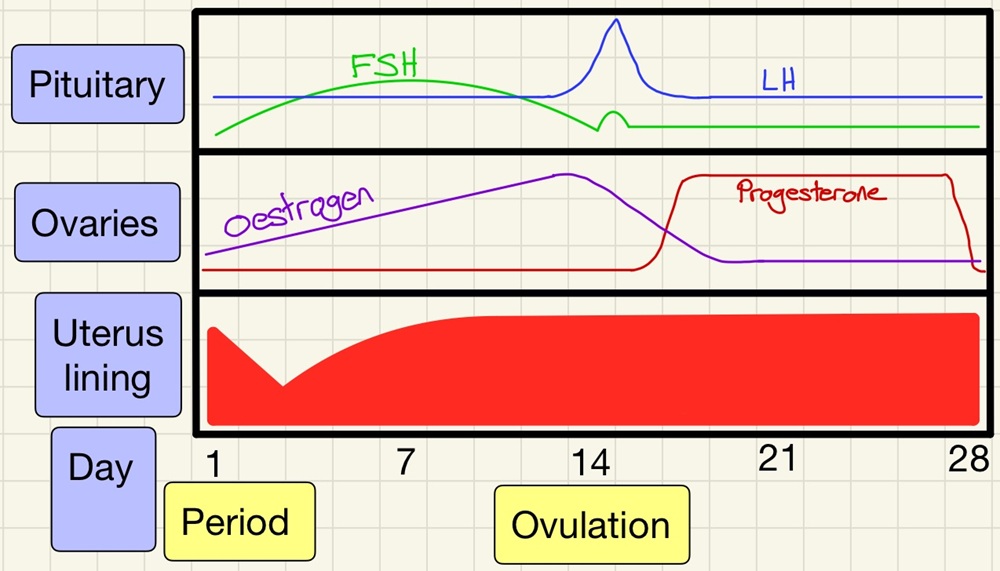Homeostasis and Response
What we are learning:
Homeostasis:

Homeostasis is a term to describe that the body likes things to me the same. When things are changed, your body does not like it. The body has evolved to use both the nervous system and the endocrine system to keep conditions in perfect balance. Whether you notice it or not, your body checks the conditions and makes alterations as needed.
The nervous system:

The nervous system has evolved to detect the world around us. Think about our senses, they are all transmitted through nerves to our brains. This is how we (consciously or unconsciously) detect if there is danger, food, clean water, shelter etc. so that we can best look after ourselves and keep ourselves alive. We start with the brain and the spinal cord, these are the central nervous system or CNS, we also have the peripheral nervous system which consists of the nerve cells that transmit the information from the receptors to the CNS then back to effectors. This system is beyond critical to us, imagine life without any of your senses.
The reflex arc:

In order to protect our bodies, there are some instances in which our CNS bypasses our conscious decision making ability and simply protects itself on "autopilot". These automatic responses are based on a stimulus that the CNS deems a danger to ourselves. Examples include:
• Blinking
• Pulling your arm away if your hand touches something hot
• Breathing no matter how hard you try to hold your breath
These are all involuntary responses. In these cases, the nerve impulse comes from the receptor in your finger, along the sensory neurone and across a relay neurone in your spinal cord. It then passes the synapse and returns along the motor neurone to the effector which will be the muscles to move your arm away. Here, the brain never gets a chance to make a decision, the decision is automatic to protect yourself from burns, infection and even death.
To look in more detail at reactions and reaction speed, there is a required practical for this.
The endocrine system:

The other system that helps us to maintain conditions within the body is the endocrine system. This system is made up of glands that secrete chemicals called hormones. Unlike nerves which are fast-acting and short lived, hormones are slower to act and they continue to work for much longer.
• Adrenal glands - adrenaline - speeds up heart and breathing.
• Thyroid gland - thyroxine - regulates metabolism.
• Ovaries - oestrogen/progesterone - female sex hormones.
• Testes - testosterone - male sex hormones.
• Pancreas - insulin/glucagon - regulate blood glucose.
• Pituitary gland - the Master Gland which controls all others.
The nervous system works closely with the endocrine system, when receptors pick up information and pass it onto the CNS, a signal is sent to an effector. Effectors are not just muscles, they can be endocrine glands too.
The control of blood glucose:

Your body can detect the concentration of glucose in your blood via the pancreas (an area called the islets of Langerhans). It is critical that your blood glucose stays within a specific range for the health of the rest of your body. When you eat, and carbohydrates are broken down, glucose levels in your blood will rise so your pancreas will secrete the hormone insulin. This hormone travels around the blood stream and it causes the cells to absorb glucose into them and this lowers the amount of glucose in your blood. As the levels of glucose fall, insulin production stops. In the liver and in our muscles, glucose is converted to glycogen for storage.
If your blood glucose falls too low, as happens during and after exercise, the pancreas will secrete another hormone called glucagon. When glucagon is released into the bloodstream, it arrives at the liver and it makes the liver convert glycogen (stored carbohydrate) into glucose which gets into the bloodstream raising the blood glucose level.
In type 1 diabetics, like myself, the pancreas just cannot make enough insulin to maintain healthy blood glucose levels. In order to check the glucose levels, diabetics often prick their fingers and test a sample of blood. I, like many diabetics now, have a sensor on my arm which is constantly detecting the glucose levels, when I eat, or when the levels of glucose are too high, I inject insulin. This mimics the pancreas's role just not as efficiently as the natural process. Type 2 diabetics tend to be controlled by diet, the reduction of glucose taken in allows the pancreas to cope and manage the glucose levels.
The menstrual cycle:

In men, the release of testosterone from the testes has many effects around a male's body but as far as reproduction goes, it causes the production of sperm cells. In females there is the evolutionary masterpiece that is the menstrual cycle. This is a basic outline of the hormones, their role and the order in which they appear.
• The pituitary gland releases follicle stimulating hormone (FSH) which matures an egg in an ovary.
• At the same time, oestrogen is released more and more to thicken the lining of the uterus in preparation for an embryo to implant.
• At about day 14 (this varies female to female) luteinising hormone (LH) is released which causes the matured egg to be released and float down the fallopian tube.
• Oestrogen levels fall at around day 14 (ready for the release of the egg) and LH/FSH drop off on day 15.
• From day 14 to around day 21, progesterone is release from the empty follicle in the ovary and it maintains the thickness of the uterus lining. When this progesterone production falls off, the uterus lining will become ready to shed as the monthly/menstrual bleed. If there is an embryo implanted (pregnancy), then the progesterone level will remain high.
Contraception and infertility:

Contraception is preventing pregnancy. Methods such as condoms and diaphragms are called a "barrier method", a barrier is placed to prevent sperm cells from meeting egg cells. Here we are going to discuss how hormones are used to stop the release of FSH and LH so that an egg is neither matured nor released. FSH and LH will not be released while there is progesterone present. As we said in the last component, if there is progesterone, the body thinks it is pregnant so there is no need to release another egg so FSH/LH are stopped. There are other methods of delivering hormones than the pill such as injections and by the implant.
Other methods as well as the hormones and barrier methods: IUDs, spermicides, surgery/sterilisation and, of course, abstinence.
We have seen how hormones can be used to prevent pregnancy but they can also be used to dramatically increase the chances of pregnancy for people who are not able to conceive naturally. Once fertility specialists have diagnosed what might be reducing a couple's chances of conception. Doctors can inject hormones into a woman to replace hormones that are not being produced naturally or in large enough quantities. If this still does not help, hormones can be used (FSH/LH) to make a woman mature and release a quantity of eggs at once, these can be harvested and fertilised in a clinic then (after oestrogen injections to thicken the lining of the uterus) the fertilised eggs and be returned to the uterus. Progesterone will also be injected to maintain the thickness of the uterus lining. This is in vitro fertilisation IVF. As well as being very expensive, this is an invasive and uncomfortable process so it is used only when other methods fail.
Key words/terms for this topic
Adrenal gland Adrenaline Central Nervous System Contraception Coordination Diabetes Effectors Endocrine system Fertility Follicle stimulating hormone (FSH) Glucagon Homeostasis Hormone In Vitro Fertilisation (IVF) Infertility Insulin Involuntary Luteinising hormone (LH) Menstrual Cycle Metabolic rate Negative Feedback Neurones Oestrogen Optimum Ovary Ovulation Pancreas Pituitary gland Progesterone Reaction Time Receptors Reflex action Reflex Arc Relay Neurone Sensory Neurone Spinal cord Stimulus Synapse Testes Testosterone Thyroid gland Thyroxine
Curriculum Health Check:
Q: What does homeostasis mean?
A: Maintaining relatively stable internal conditions
B: Maintaining ion levels in your blood
C: Maintaining a constant level of hormones in your blood
D: Maintaining contact throughout your nervous system
What you need to know
Explain that homeostasis if the process of keeping conditions the same. This includes blood glucose levels, body temperature and levels of hydration. These are crucial for enzymes to work optimally. This is maintained by a series of receptor cells that detect conditions, coordination centres like the brain or spinal cord and effectors which are muscles or glands that make the change.

Our nervous system allows us to sense the environment around us. The central nervous system (CNS) is the brain and spinal cord. The CNS receives information and instructs a muscle of gland to react.

The reflex arc ignores the brain and just passes the spinal cord, these reflexes are essential for self preservation and so your brain does not get a chance to stop this "involuntary reaction".

Homeostasis is not only controlled by the fast acting/short lived nervous system, it is controlled by slow acting/long lived hormones. The endocrine system secretes chemical messages called hormones, the master gland is the pituitary gland in the brain, the glands are:

• Pituitary gland

• Pancreas

• Thyroid

• Adrenal glands

• Ovaries

• Testes.

You need to be able to describe how blood glucose levels are managed with the hormone insulin. You also need to know about type 1 and type 2 diabetes, what are the causes, effects and treatments. You may be asked to translate data or graphs of blood glucose levels.

The menstrual cycle is controlled by a series of hormones. You need to be able to describe their roles. During puberty, these hormones start the development of secondary sexual characteristics. You need to know about testosterone, oestrogen, FSH and LH.

Be prepared to evaluate different forms of contraception, both hormonal and non-hormonal methods. These methods control fertility. These include:

• The pill which contains hormones to stop FSH maturing an egg.

• Implants with slow release progesterone to inhibit egg release.

• Barrier methods like condoms and diaphragms.

• Intrauterine devices which prevent egg implantation.

• Spermicides which kill sperm cells.

• Abstinence when eggs are available to be fertilised.

• Surgery: vasectomy and tying fallopian tubes.

Extra topics needed for the Higher Tier papers:

As well as insulin, the pancreas produces glucagon which converts glycogen into glucose if the blood glucose levels fall too low. You need to explain the negative feedback relationship between glucagon and insulin during blood glucose level control.

You not only need to know the roles of progesterone, LH and FSH, you need to know how these interact with each other during the menstrual cycle. You may be expected to interpret data of hormone levels and uterus wall thickness.

This page was updated on: 9th April 2024

